A lot has happened in the last three weeks. We have put our plans on hold for this summer, and are staying at our home in Charlottesville, Virginia until the virus situation gets worse and then better. Fortunately, we are both naturally socially distant.
Ireland and Scotland
Because Olive Oyl is on-the-hard in Plymouth, UK, our logistics are a bit easier this year. Our plan is to get to the boat toward the end of March, do some painting and light maintenance, possibly building a pair of legs, and around the beginning of April, sail to the Republic of Ireland, probably Cork, and commence traveling around Ireland in a clockwise direction toward Northern Ireland. Next, we plan to cross over to Scotland and work our way up to the Caledonian Canal, through Loch Ness to the East coast of Scotland, with the intention of leaving our boat somewhere in Scotland for the Winter of 2020-2021. Complicating the plan, somewhat, is the European travel ban announced last night by our president, Donald Trump. It seems that this ban shouldn’t affect us, since we are US citizens flying to Ireland and the UK, and we are functioning as “sea crew”, but it is possible we will suffer from some unintended consequences. Who knows,? Time will tell.
Transatlantic Passage: The last day
We have been sailing a long time, and are ready for a break. Specifically, we are looking forward to some good Cornish Pasties, some Guinness beer, and that staple of British cuisine, Chicken Tika Masala. We have been listening to BBC on the radio, where they are talking about the new Prime Minister Boris Johnson.
The last several days have been windy and rough, and not conducive to writing anything. We have had a brief respite today, with wind of 7 – 9 knots. We used these hours to take showers, shave and shampoo. Salli made some cherry cobbler, which really hit the spot. As I start to write this, it looks like the wind is picking up again. We will see how it goes.
This is one of the craziest things we have ever done, and it seems, we have pulled it without much hardship. We do of course have to get the boat home at some time, all details yet to be determined.
CHECK IN A FEW DAYS FOR A NEW SHORT VIDEO HERE
Today, we had some porpoises swimming around the bow, and I got a quick video of them which I will add to this post, in a couple days, once I get the bandwidth. Last night, we saw them jumping completely out of the water, 100 feet from the boat.
The one major trouble we have had on this trip has been communication. Up to now, we have relied on the Winlink system to send and receive emails. As a Ham radio licensee, I am entitled to use this network, and it has been great. There are hundreds of amateur stations that are left powered on, around the world, day and night, allowing me to contact them, log on, and digitally send and receive emails anywhere through short wave radio, at no charge, and with no data limit. This is how I post my location reports, make inquiries about technical problems, and how I post blog posts I make while underway. Apparently, the FCC has been cracking down on the amateur radio community, which has caused the amateur radio community to start policing itself more energetically, and what did they discover? That there have been “third party communications” taking place between the USA and other countries, which the USA does not have reciprocal agreements with. Most of these countries are located in Europe, where I am.
Who are these parties? The first party is me. The second party is the Ham at the other end of the radio link, in this case the operator of the ground station. The third party is everyone else, who the other parties communicate with or help to communicate. In nearly all cases, my emails are considered third party communications, and can no longer be conducted through ground stations in Europe. If I want to send them, I have to use ground stations in Canada, a country we have an agreement with. This is much more difficult to do, since radio contact is only reliable at this distance, at certain random times of the night. This change was announced Saturday morning, and put into effect within hours, with no concern to those at sea like myself, who are relying on Winlink emails to make safety, weather, and emergency communication. I will be posting this blog, if I can, through Amateur Station VO1MFK in Halifax, 3247 kilometers distant.
As I write this, we have 120 miles to go, 1/10 of our original distance. We still have 80% of our diesel fuel, and 40% of our water, and are starting to be less careful about conserving it, using water for such unthinkable extravagances as washing the salt off the cockpit seats. We opened the last bag of gummy bears, and been taking a hard look at the last sausages.
One Third of the Way to Falmouth.
We are having a lazy day, a good one for writing. Wind is exactly blowing toward our destination, which is a mixed blessing. Of course, a boat cannot possibly sail directly into the wind, but it is also difficult to sail directly away from the wind. The sails, being one in front of the other, tend to block each other, making the jibs flap around, which is hard on the sail, hard on the nerves, and makes it hard for the windvane, which has to apply different corrective forces, depending on which sails are drawing, and the wind direction. It is best to “tack downwind” under these conditions. For this reason, we are sailing a bit to the left of our ideal course. Conditions change hourly, so at this point, we can be flexible with our direction. There is no land to hit within 4 or 5 days sail, so we can relax.
It is 2:15 PM boat time. Salli is taking a nap. I am catching up on paperwork. Swell is 3 foot, and gently rolling, so our appetite is better, We had a good breakfast with eggs and coffee. We plan our meals around our appetite, but also around the safety of the cook. Even though our stove is gimbaled, when it is rough, hot liquids (oil and water), can be dangerous; the oven and pressure cooker, relatively safer. Tonight we will probably have fried pork chops, a dangerous meal. Our diet is also dependent on the state of our icebox. We filled it up with 18 kg of ice Thursday. It is Wednesday, and, because of the low water temperature, we probably have 1/3 of our ice left. We have pork chops, and a 1/2 kg of ground beef, good for two or three meals. After the ice is gone (Friday, or Saturday), we will have some cheese that will be good for another week or so, but mostly canned, and baked food, and UHT boxed milk. We have fruit, but only potatoes and onions for vegetables. The Azores was a good place to provision. They grow a lot of cattle there, which makes for good prices on beef and milk. The milk is only available in UHT boxes (Ultra High Temperature pasteurized), even though it is local. They also grow their own bananas, which are about half the size of our standard (Cavendish) South American bananas. They are also sweeter, and don’t get mushy as quickly; they have a custardy color and texture. We have only one left, and it will be sad to see it go. I would love to find out the variety name of this fruit.
Our cabin is a mess. We are using the starboard bunk/settee for sleeping, and are using the port bunk for “storage”; a place to throw clothes, papers, books, charging cables, phones, music, and pillows. All of this stuff is restrained with a “lee cloth”, a rugged piece of fabric that is clipped in position to prevent sleepers from rolling out of bed. When sleeping, the waves roll us around a bit. We sleep on the low side, so we are rolled toward the hull, and not off the bunk onto the floor. When we tack next, after a meeting of course, we will have to swap the two bunks, which will make for even more chaos.
We carry 50 gallons of water, and have an electric watermaker, and two manual watermakers. In the last 5 days, we have used less than 10 gallons. The weather is on the cool side, and we have been drinking less (and washing less), as a result. We also budget some water for washing salt out of the cockpit.
Salli does most of the cooking. I have my specialties, slow cooked bacon, barbecue, bread, and anything requiring a pressure cooker, but Salli generally cooks everything else, mostly, I believe, to keep my heavy hand away from the hot sauce. We usually eat in the cockpit, where we have a dining room that stretches to the horizon, where we can keep an eye on sailing progress, and where spills are easily cleaned with a bucket of seawater. When we are done, I wash the dishes in a bucket of salt water, and rinse them in fresh water using a garden sprayer; Salli drys them and puts them away.
When we are alone on watch, time can weigh heavy. Salli does some knitting, listens to audio books, and reads paper books when the sea is not too rough. I write and send emails, do minor repairs like sharpening knives and securing equipment, and watch movies, being careful to look around for traffic every 15 minutes or so.
We will be halfway in a couple days, always a great day.
Leaving Horta Today
We left Horta an hour ago at 10:00 AM. Last night, I realized we needed to change the oil (Oyl?) in the engine, so we spent a couple hours doing that before leaving. Due to the magic of modern technology, I am writing this as Salli steers us NE toward Falmouth at 5 knots. The wind was supposed to be light, but it is 12 knots right now. It may drop down as we leave the influence of the Azores islands. We expect to be heading North, and possibly Northwest over the next few days to get up to latitudes where there is more wind. Don’t be surprised if we head for Iceland for a few days.
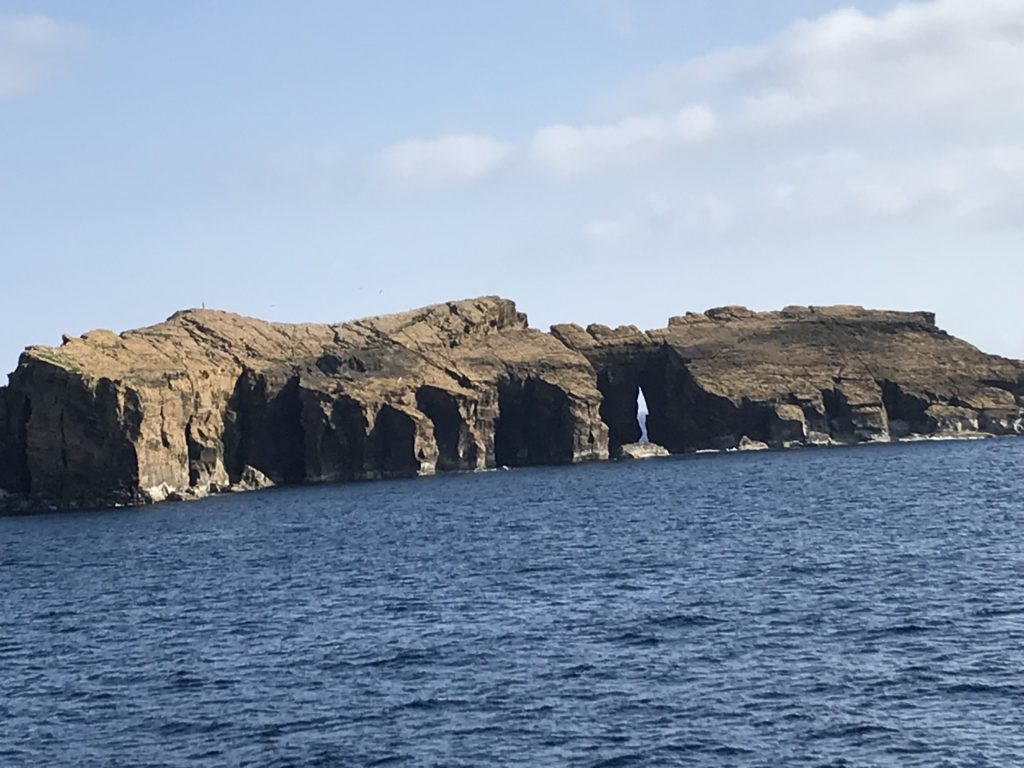
Tuesday we took the ferry from Faial to Pico, the closest and largest of the Azores islands. Pico is more obviously volcanic than the other islands, because of its cone shaped appearance. We hired a taxidriver, Gonzalos (pronounced Gonsalo). Who drove us around for most of the day. There were lots of houses and barns made of volcanic rock, and entire vineyards where the vines were protected by hand made dry walls of volcanic stone. It was difficult to see what dirt the vines were growing in, there was so much black rock.
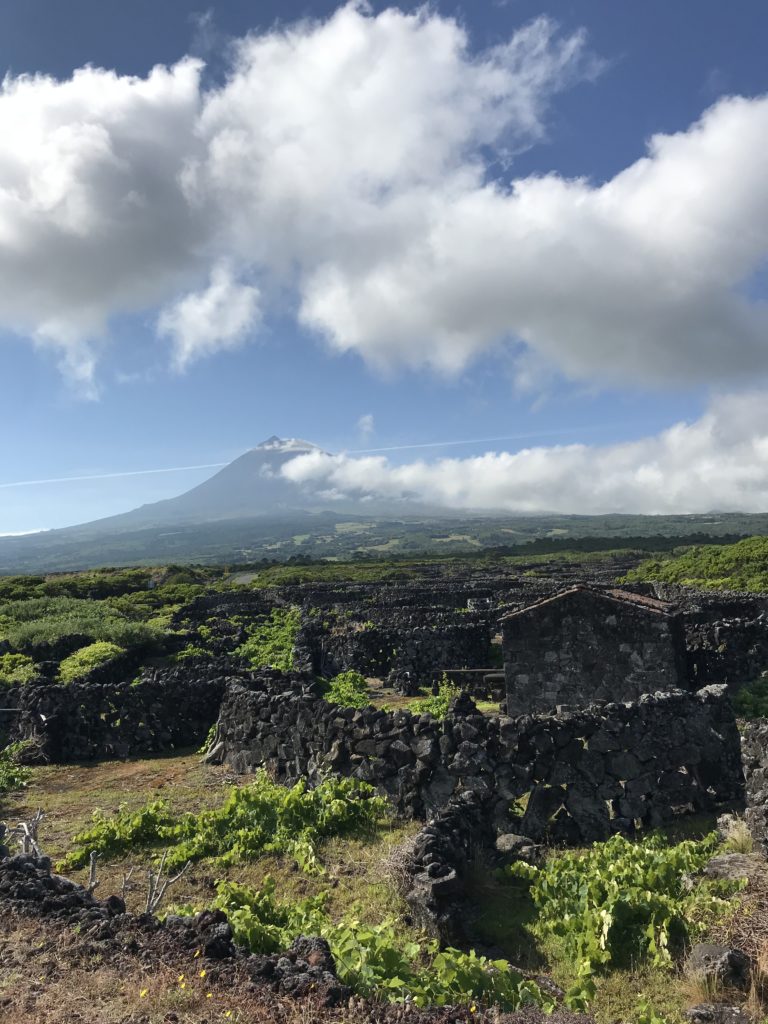
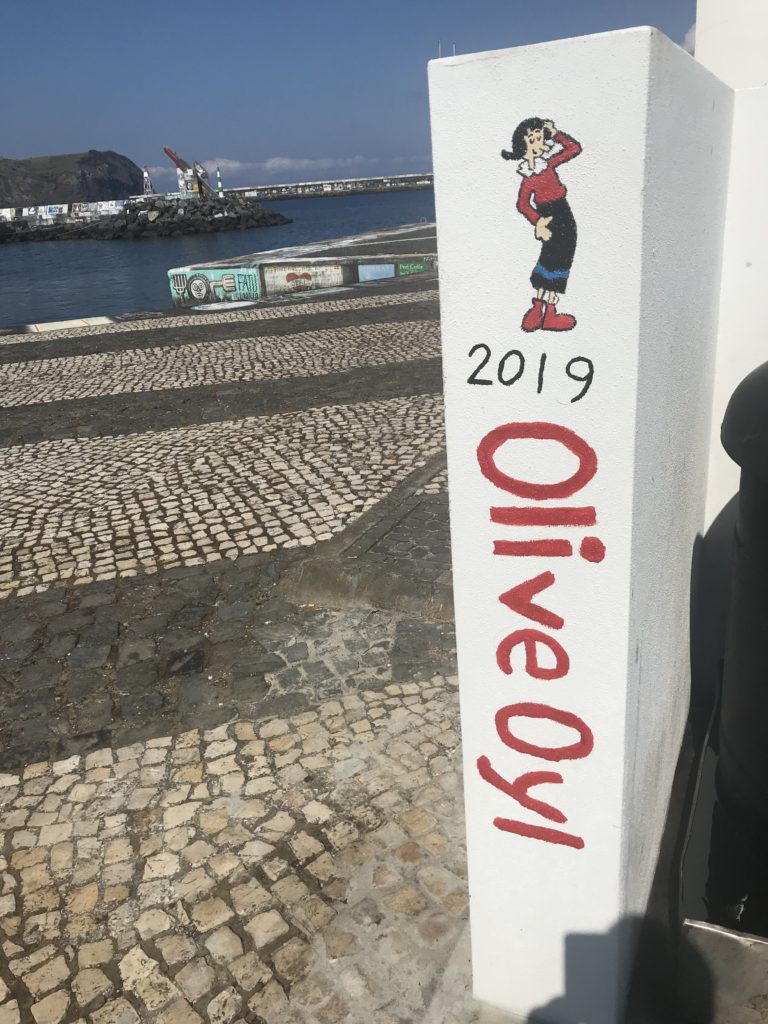
Wednesday, we performed the Horta tradition of painting our boat name on some convenient piece of concrete. If you go to Google Earth, you can see thousands of them on every possivle horizontal space. We picked a horizontal space and painted Olive Oyl’s likeness and name.
Yesterday, we spent getting ready to leave. Water, ice, food, trash, paying our marina bill (130 Euros for 11 days.. Wow!). We bought a Reeds Almanac of England, Ireland, and the rest of Europe.
Horta
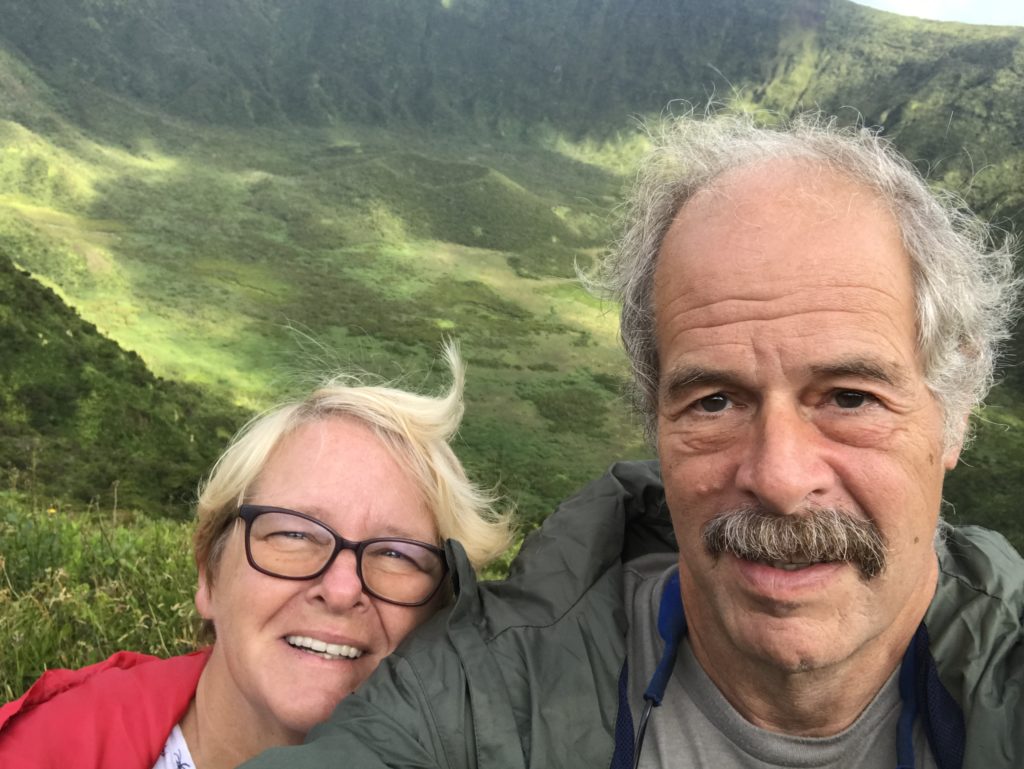
We arrived in Horta, Monday afternoon, after 20 days at sea. It was a lazy sail into the Horta Harbor. We checked in, and were happy to find out that, because of our diminutive size, we could be accommodated in a slip. This is the high season, and other, larger, boats are required to raft up as many as four deep. This means walking across other boats to get ashore.
Looking back on the last 20 days, We don’t have much to complain about. We only had 3 or 4 days that we would consider “rough”, and these were quite manageable. The rule of thumb we use is 100 miles per day average. I predicted 21 days, so our actual time was quite acceptable. There is an awful lot of water out there. During this time, we never saw another human being, we only saw 6 ships and one other sailboat. As a marital experiment it was a success. It seemed to me that we got along at sea at least as well as we do on land.
The Azores (accent on the second syllable) consist of 9 islands and numerous harbors and anchorages, some better than others. Horta, on the island of Faial, seems to be the favorite among sailors, since they have a good commitment to accommodate anyone who shows up. This is the high season, so there are a lot of sailboats here. Weather is a bit cooler than home, with daytime temperatures a bit on the warm side and night time temperatures a bit on the cool side. Horta is part of Portugal, and the European Union, and we use Euros here ($1.12). All the local people have been welcoming. Most speak English well enough to help us find what we are looking for. Portuguese is a romance language like Spanish and Italian. There are many similarities between Portuguese and Spanish, although the Portuguese don’t appreciate being reminded of this. I once had a Portuguese man tell me that his language was most similar to German.
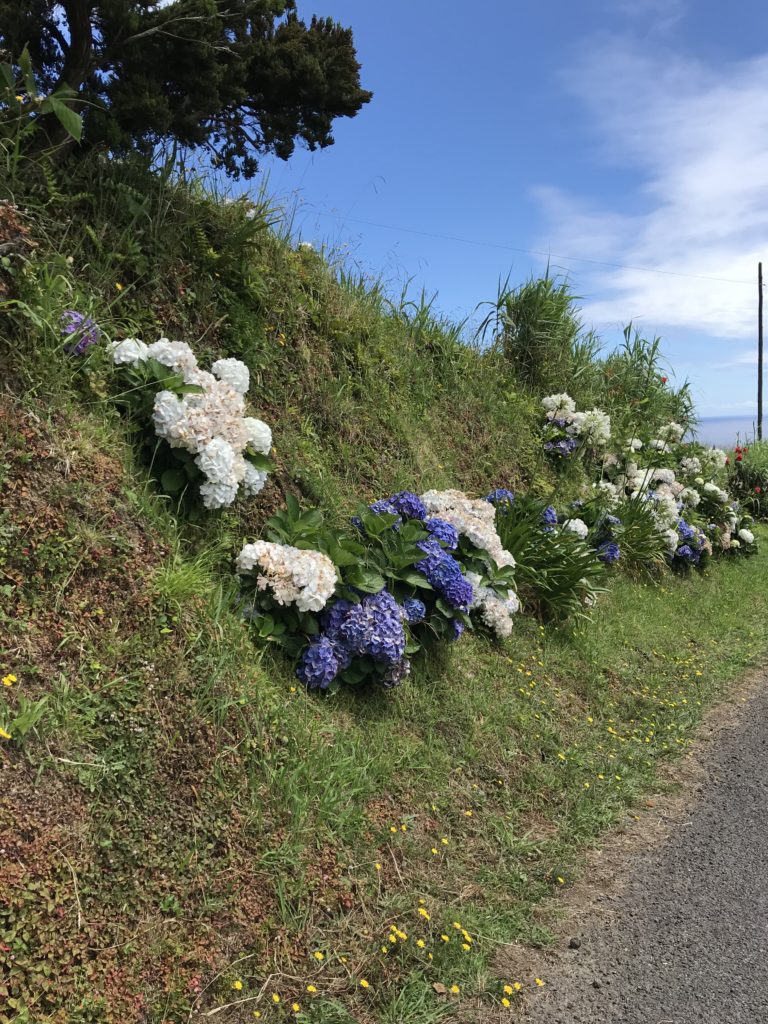
Yesterday, we rented a car and took a tour of the Island of Faial. The rental agent told us to take our time, since it is possible to drive around the whole island in one hour. Our Renault had 5 gears, but we never needed to use gears 4 and 5. There is a caldera, the crater of an extinct volcano, and the volcano that erupted out of the ocean in 1958, causing much havoc (and emigration to the USA) at that time. We saw these features as well as pastoral scenes of grazing cows, cedar forests (or was it cypress), and narrow country roads . For some reason, Faial hosts a surprising number of blue flowers, most of which are hydrangeas. They are growing in yards, between fields, and along the road. Clearly they are happier here than the one growing in our yard at home.
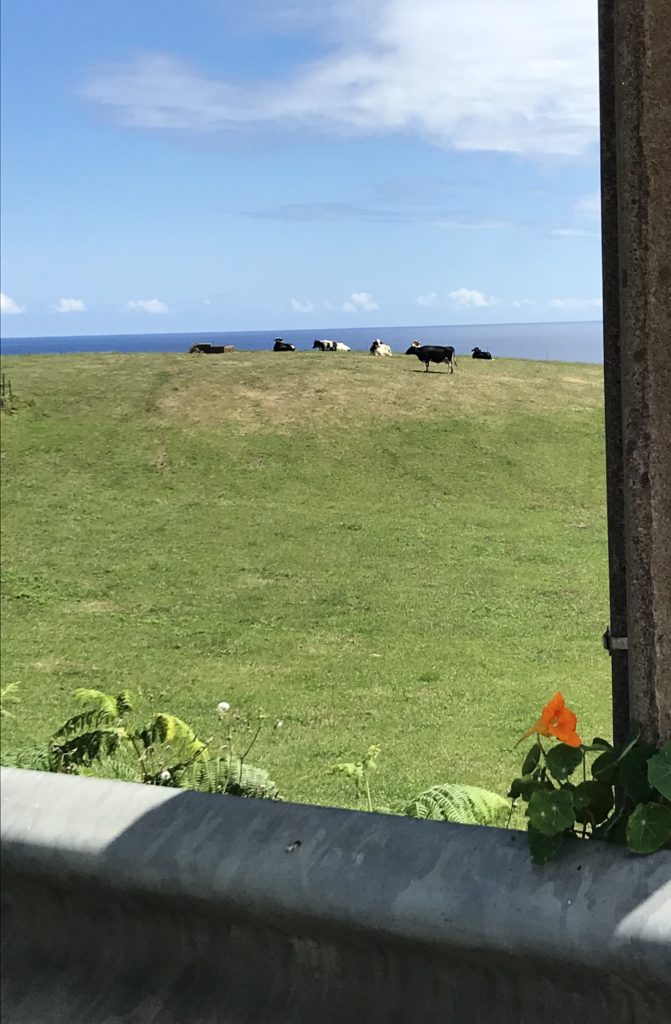
Today, we are doing some housekeeping chores. Fuel, ice, water, paperwork. bills, repairs, etc. Before I returned the car this morning, I went to the wholesale fish market to buy ice. The price there was 0.26 Euro per kilo (the grocery store wanted 1 Euro). This afternoon, we are going to the library to print out sheet music for an upcoming week of song in Oxford, with my hometown community chorus, Zephyrus.
Salt and Pants
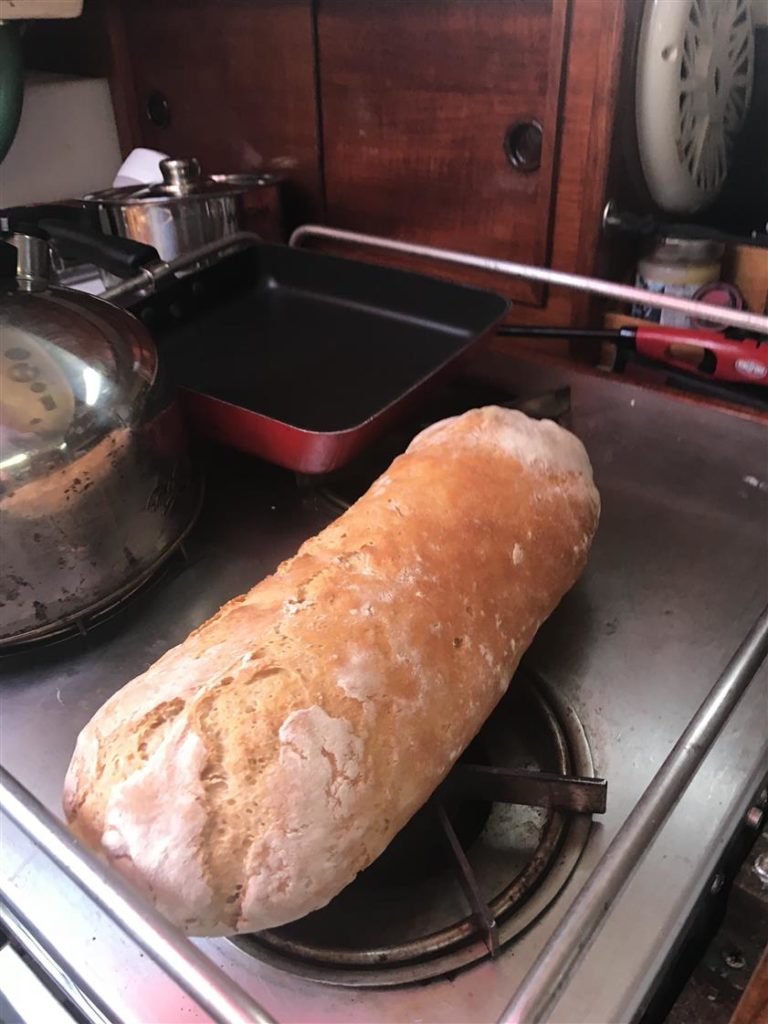
Today is our 11th day sailing from Bermuda to The Azores. Our progress was a bit slow at first because we didn’t have much wind, and because we had to go out of our way to the North in order to find more wind. We had rain most of the first day, and not much since then. On the whole our weather has been delightful with weather much like we have at home, but a bit colder. Our wind has ranged between 5 knots and 23 knots. 5 knots will push us along at approximately 2 knots, and anything higher than 17 will give our maximum (hull) speed of 6.5 knots or so. The wave heights have generally ranged along with the wind speed: Less than 11 knots of wind giving us 1 or 2 foot swells, 15 k wind giving us 4 foot swells, and 19 k giving us 6 or more. This relationship creates an inverse relationship between comfort and progress.
Watch: For the most part, our steering is automated for us. Our job is to maintain a watch at all times (someone awake and scanning for other traffic, and misbehavior of the boat, Olive Oyl, and steering system, Brutis). This takes some discipline, as there are hardly any other boats nearby. In eleven days, we have seen perhaps 5 cargo ships and no other sailboats. We have seen 3 or 4 sailboats on our radar-like AIS display, but none close enough to see by eye. Salli and I each take an average of 12 hours watch a day. This doesn’t mean staying on deck at all times, The person on watch can go below to make something to eat, or track down some errant piece of clothing, so long as it doesn’t take too many minutes.
Sleep: We both get a full 8 hours of sleep, usually more. Our rule is: if you want to, take a nap. Our watches at night are 3 hours long, so too is the sleep for the other crewmember.
Free time: Simple math would indicate only 4 hours of free time, but, like the night watchman, some reading, podcast listening, and email writing can be done during watch. In my case, I have been doing more and more maintenance as the trip progresses and my stomach gets more and more accustomed to constant motion. Wednesday, I fixed a reefing cheek block on the boom. This involved sheeting in the end of the boom, so it was accessible from deck, donning a safety harness, and removing the reef line and block, installing a new block in a slightly different position, drilling and tapping holes, etc. All the while hanging off the side of a sailboat, sailing at 5 knots, while Salli acted the part of the operating room nurse, handing me tools and screws. It sounds worse than it was. Even Salli, having been briefed beforehand, and seeing the reality, thought it was fairly easy. Wednesday, I also discovered that my AIS transmitter was not transmitting, and that it was due to a problem with the antenna. We have three VHF antennas, and it was easy to swap two of them once I figured out what the problem was. I also fixed the electrical system ammeter.
Yesterday, I fixed the watermaker, and today, I fixed it again. It looks like I may have to fix it tomorrow too. Not to worry though. We currently have 30 gallons aboard. Today, I baked sour dough bread.
Salt: As the sea gets wavier, more of it comes onboard. These are not the angry surfer pipelines, but gentle larger waves that have some foam at the top, which is often tossed onboard. This is a constant irritation, once it gets in your clothes you cannot get it out. You can hang them out in the sun, but that only increases the concentration of the salt, which attracts more water from the atmosphere. With an unlimited fresh water supply, we could rinse them out, but rinsing takes a surprising amount of water. The only solution is to wear foul weather gear, or dispense with clothing altogether. Not a great option when it is cold.
The most difficult task.
Salli and I have discussed this a bit, and we are in agreement on this one: The most difficult task aboard a sailboat underway in a seaway, is putting on your pants. Think about it, how do you put your pants on at home? You need both hands, and twice, you need to lift a foot off the floor. This is difficult at home, and is best accomplished leaning up against something, or sitting on a high mattress. When everything is moving around, you need one hand just to hold on. You can lean against something, but that something may move past vertical, throwing you off, and making you let go of your pants to keep your ballance. My technique is to wedge my shoulders into the doorway to the head. This works because my shoulders are a bit wider than the doorway. Salli’s technique is to stand in front of the hanging locker and lean her head against the door. Another method would be to lie down in the leeward bunk and squirm into them. Are there any experienced cruising pants-wearers with advice on this subject? I, for one, am considering trying a kilt or bathrobe.
The Perils of Seaweed
Yesterday was the third day of our trip from Bermuda to the Azores. It was a lovely day with nice daytime and nighttime temperatures. It rained once last night for 40 minutes, otherwise partly cloudy skys. Those of you who are following our “LOCATION” section, must think we have overdosed on island rum, as our path is heading North for Canada, but we are trying to get north to stronger winds. I am on watch now, it is 5:00 AM local time, and the skies are just starting to lighten in preparation for the coming sunrise.
This part of the Ocean is home to the Sargaso weed. Indeed, it is called the Sargaso Sea. We see it floating by in basketball size clumps, several at a time. It is generally innocuous, but has a way of causing trouble in various ways. On the way to Bermuda, we were motoring through the Gulf Stream, and went through a patch of the stuff the size of a basketball court. Olive Oyl slowed down from 5 Knots to about 2.5 Knots, and wouldn’t resume her speed after breaking free. It seemed that some of the weed had wrapped round our prop and our small motor couldn’t slice through it. After pondering this situation for a minute or two, I put the engine in idle, then reverse for a few seconds, then back to forward. This procedure cleared the mess, and we were soon back at cruising speed. I have used this trick a few times since when I felt we weren’t going quite as fast as we should, and it has always restored a bit of speed.
We have a mechanical windvane, named Brutis, that we use to steer Olive Oyl any time we are under sail. It is manufactured by a company called Monitor. It monitors the wind direction, and makes adjustments to the rudder to maintain that wind direction. So long as the wind is steady, it will steer the boat better than Salli or I can do it. If the wind changes, say 40 degrees to Port, Brutis will blindly follow, and steer the boat 40 degrees to the left. This windvane is extremely reliable, but it has one weakness: seaweed. Yes, Sargaso gets wrapped around the windvanes water paddle, causing it to make weaker and weaker course corrections. The solution is to release the paddle, allowing it to swing back towards its storage position, and then immediately pull it back to its working position.
We also have a water powered generator that we use on long passages. It trails a rope behind the boat with a small propeller on the end. A reliable system, except for the proclivity to pick up, you guessed it, Sargaso. The generator is a bit harder to clear, since 75 feet of rope needs to be hauled in, and before that is done, the rotation has to be stopped. The procedure is to attach a 12 inch funnel around the rope and let it slide back over the prop and seaweed. The rope and propeller can then be hauled on deck, the seaweed cleared, and rope and propeller tossed back into the water. Last night, I was hauling the rope and felt an odd slimy bulge in the rope, the consistency of squid. In the dark I could just make out a tentacle trailing out from the rope. It seems we had picked up pieces of a Portugee Man of War. I did receive one small sting, while clearing this mess, and count myself lucky.
Our last day in Bermuda
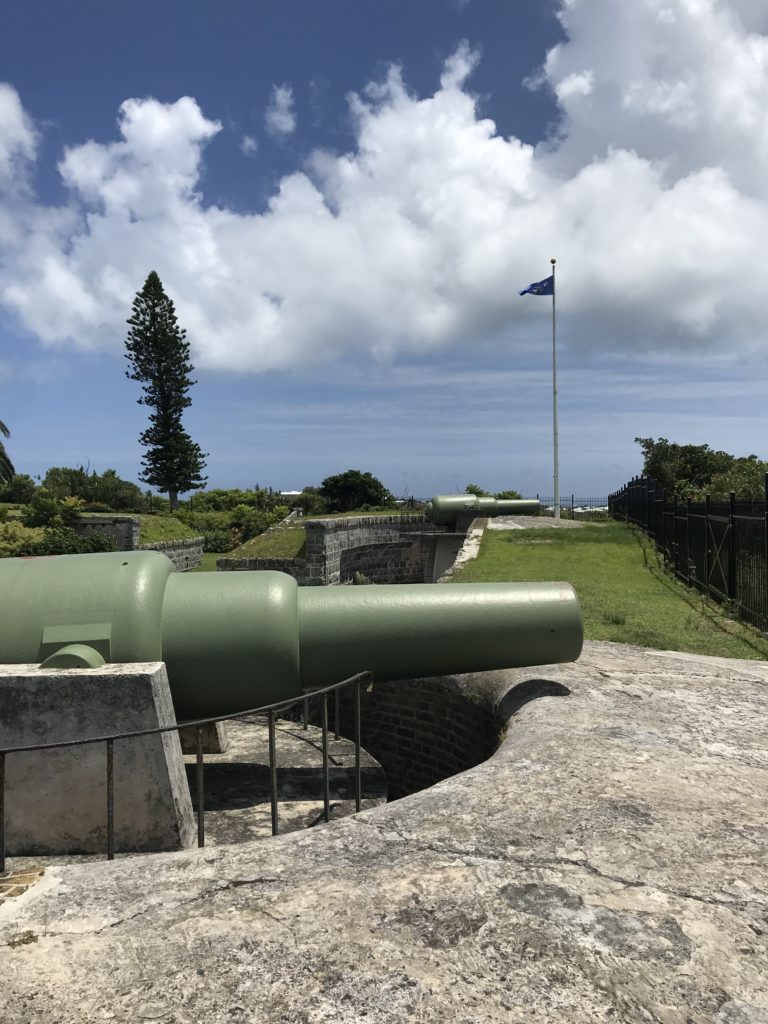
The last eleven days, we have seen the typical tourist sights, participated in the economy, washed clothes, bought water and ice and diesel fuel, Talked to local Bermudans, fellow cruisers, and to tourists, and we have developed a view of Bermuda.
Bermuda is a wealthy country, with income equivalent to the USA. We were told that a pool man makes $60,000. We have seen little evidence of a poor economic class. Yes, there are the elderly, disabled, and infirm, but they seem to be cared for by the system. Not once were we hassled by a panhandler, or approached with some tourist hustle. Walking down the street, strangers will say “good afternoon”to you. Salli, during a visit to the grocery store, asked for a bag of ice, and was gently chastised “and good morning to you too”. Bermuda uses the $US as currency, like The Bahamas and Ecuador, so it is easy to compare prices. On the whole, things cost a bit less than double the US price. This is not the Bermudians taking advantage of the tourists. They pay these prices too. Nearly everything is shipped from someplace else, by ship or airplane. There is no farming, and little industry. Diesel fuel is $1.90 per liter, which works out to about $7.30 per gallon, but there is a hefty amount of tax in this. We were offered duty-free pricing which was more like our price at home. Beef and chicken were higher, but not lamb. Oddly, the Bermudians seem to eat little fish, even though we found fish jumping out of the water at our anchorage. The only fish in the grocery store was shrimp, salmon, canned sardines, and salt cod. There are fishing trips for tourists, but little evidence of commercial fishing. A waitress told us there was no fish market in Bermuda.
We are planning to leave for The Azores tomorrow morning: 1800 miles, three weeks perhaps.
Last minute tasks: laundry, water, dive (snorkel) to clean hull, mail letter to IRS, check all rigging, fold up and secure dinghy, groceries, 50 lb ice. We got our ice at the grocery store; when we were checking out, we realized we had way too much for two adults to carry: not to worry, we were told we could take the cart to the waterfront, if we promised to bring it back.
Ahh… Bermuda!
We post here every few days, a detailed description of our trip. While we are underway, it is sometimes tough to write much, but we try to update our position every day along with a one or two sentence description of our day. Go to the “LOCATION” page, click on winlink.org, and hover over each point on the map.